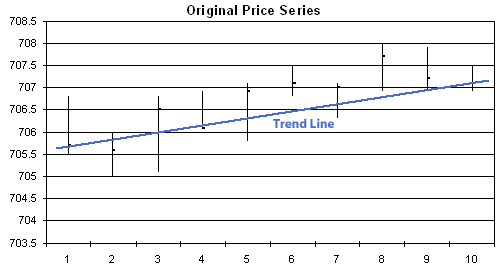A Noise Tolerant Money
Management Stop
One money management technique
that many traders use is a money management stop. A money management stop is a
protective stop order placed below the entry price for a long trade or above the
entry price for a short trade. It provides an automatic exit point in case the
market reverses. Where the stop is placed often makes the difference between a
good trade and a bad one. If the stop is placed too close to the entry price,
the trade could be stopped out by normal market activity before the trade
has a chance to develop. On the other hand, if the stop is placed too far from
the entry, the loss could be much larger than necessary if
the stop is hit.
Some common
methods for selecting the placement of a money management stop
include (1) fixed dollar amounts (e.g., a $200 stop in the E-mini S&P
implies a stop size of four points), (2) support/resistance levels (e.g., recent
highs/lows), and (3) a multiple of the average true range (ATR;
e.g., three times the ATR below the entry for a long
trade).
While all these methods have
merit, they also have potential problems. Support and resistance levels tend to
attract trading activity, so placing stop orders there can make it more
likely the stop will be hit. Fixed dollar stops have the merit of simplicity but
don't adapt to changes in market volatility. A $300 stop, for example, may
be large enough when market volatility is low but may be too tight when the
volatility increases. Taking a multiple of the average true range is a way to
adapt to changing volatility, but the multiplier becomes another system
parameter. There is typically no obvious way to choose the multiplier other than
through back-testing, which effectively means optimization.
With this in mind, I decided to
develop a money management stop that adapts to market volatility and requires no
optimization. I call it a "noise tolerant" stop. It's based on the idea that
market movement consists of two components: trend and noise. The trend component
is what we're trying to trade; going long in an up trend or short in a down
trend. Superimposed on the trend is the noise component. The noise component is
all the up and down activity within the trend.
Notice that the definition of
noise depends on the trend we're interested in. If, for example, we're trading
one minute bars and our average winning trade lasts 15 minutes, then the trend
is defined as what happens over that 15 minute period. In this case, the noise
is the deviation from that 15 minute trend. On the other hand, if we're trading
monthly bars where the average winning trade runs for, say, 14 months, then
the noise is the deviation from that 14 month trend line. Clearly, the noise
will be greater for a longer time frame.
As the name suggests, my noise
tolerant stop is sized according to the noise component in the market. To
determine the market noise, we detrend the price series and calculate the
deviation of the prices for the detrended series. Consider the price series
shown in Fig. 1, below.

Figure
1. Original price series, prior to detrending.
A trend line has
been drawn from the close of the first bar to the close of the last bar. This
represents the trend component in the price series. To detrend the prices, we
subtract this trend from the prices. The equation for the detrended prices is as
follows:
Detrended Price j = Price j - [ (C[N] - C)/N
* j + C]
where Price j is
the price j bars ago (e.g., j = 0 is the current bar; j = 1 is one bar ago,
etc.), C[N] is the closing price N bars ago, C is the current close, and N is
the number of bars back to the start of the trend. Price j can be any
price on the bar, such as the high, low, open, or close.
Applying this
equation to the price series in Fig. 1 results in the detrended price series
shown below in Fig. 2. The prices are now centered around the zero axis. The
noise can be defined as the deviation of price from this axis. The maximum
deviation for this price series is noted in Fig. 2. For my noise tolerant
stop, I first determine this maximum deviation then take the average of this
value over the past N bars. I use the average maximum deviation from the
detrended series as the size of the stop.

Figure
2. Detrended price series, obtained by subtracting the trend component from the
prices shown in Fig. 1.
In EasyLanguage
code for TradeStation, these calculations can be written as follows:
{
Function NTStop
Noise tolerant money
management stop.
This function detrends the price over the last N bars.
The maximum deviation of price from the trend line is used
to
determine the size of the money management stop, which
is
returned.
Copyright 2006 Breakout Futures
www.BreakoutFutures.com
}
input: N
(NumericSimple); { Lookback length
}
Var: HDet
(0), { detrended high
}
LDet
(0), { detrended low
}
Devi
(0), { deviation from trend line
}
MaxDev
(0), { maximum deviation
}
ii (0); { loop
counter }
{ Calculate deviation of price from trend
}
MaxDev = 0;
for ii = 0 to N
Begin
HDet = H[ii] - ((C[N] - C)/N * ii +
C);
LDet = L[ii] - ((C[N] - C)/N * ii +
C);
Devi = MaxList(AbsValue(HDet),
AbsValue(LDet));
if Devi > MaxDev
then
MaxDev =
Devi;
End;
{ Use average of MaxDev over past N
bars as stop size }
NTStop = Average(MaxDev, N);